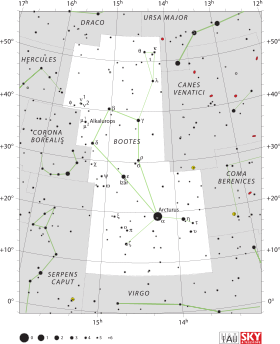Sigma Boötis
 | |
| Observation data Epoch J2000 Equinox J2000 | |
|---|---|
| Constellation | Boötes |
| Right ascension | 14h 34m 40.81699s[1] |
| Declination | +29° 44′ 42.4590″[1] |
| Apparent magnitude (V) | 4.46[2] |
| Characteristics | |
| Spectral type | F4VkF2mF1[3] |
| U−B color index | −0.084[2] |
| B−V color index | +0.366[2] |
| R−I color index | 0.19 |
| Variable type | suspected[4] |
| Astrometry | |
| Radial velocity (Rv) | +0.37±0.09[5] km/s |
| Proper motion (μ) | RA: +188.35[1] mas/yr Dec.: +131.77[1] mas/yr |
| Parallax (π) | 63.16 ± 0.25[1] mas |
| Distance | 51.6 ± 0.2 ly (15.83 ± 0.06 pc) |
| Absolute magnitude (MV) | 3.52[6] |
| Details | |
| Mass | 1.48[7] M☉ |
| Radius | 1.431±0.023[8] R☉ |
| Luminosity | 3.461±0.042[8] L☉ |
| Surface gravity (log g) | 4.30[6] cgs |
| Temperature | 6,594±55[8] K |
| Metallicity [Fe/H] | −0.24[9] dex |
| Rotational velocity (v sin i) | 7.32[10] km/s |
| Age | 1.7[11] Gyr |
| Other designations | |
| Database references | |
| SIMBAD | data |
| Data sources: | |
| Hipparcos Catalogue, CCDM (2002), Bright Star Catalogue (5th rev. ed.) | |
| Database references | |
| SIMBAD | data |
Sigma Boötis (σ Boo, σ Boötis) is a star in the constellation Boötes.
Sigma Boötis is a yellow-white F-type main sequence dwarf with an apparent magnitude of +4.47. It is approximately 50.4 light years from Earth.
In Chinese, 梗河 (Gěng Hé), meaning Celestial Lance, refers to an asterism consisting of σ Boötis, ε Boötis and ρ Boötis.[12] Consequently, σ Boötis itself is known as 梗河二 (Gěng Hé èr, English: the Second Star of Celestial Lance.)[13]
Located to the southeast of Rho Boötis, the dwarf Sigma may at first appear as a naked-eye double, but the angular proximity with Rho is merely line-of-sight. Like many of its spectral class, Sigma is apparently a variable of the Delta Scuti variety, which vary subtly with multiple periods of hours.
References
- 1 2 3 4 5 van Leeuwen, F. (2007), "Validation of the new Hipparcos reduction", Astronomy and Astrophysics, 474 (2): 653–664, arXiv:0708.1752, Bibcode:2007A&A...474..653V, doi:10.1051/0004-6361:20078357.
- 1 2 3 Elliott, J. E. (October 1974), "Study of delta Scuti variables", Astronomical Journal, 79: 1082–1090, Bibcode:1974AJ.....79.1082E, doi:10.1086/111657.
- ↑ Gray, R. O.; et al. (April 2001), "The Physical Basis of Luminosity Classification in the Late A-, F-, and Early G-Type Stars. I. Precise Spectral Types for 372 Stars", The Astronomical Journal, 121 (4): 2148–2158, Bibcode:2001AJ....121.2148G, doi:10.1086/319956.
- ↑ Samus, N. N.; Durlevich, O. V.; et al. (2009). "VizieR Online Data Catalog: General Catalogue of Variable Stars (Samus+ 2007-2013)". VizieR On-line Data Catalog: B/gcvs. Originally published in: 2009yCat....102025S. 1. Bibcode:2009yCat....102025S.
- ↑ Nidever, David L.; et al. (August 2002), "Radial Velocities for 889 Late-Type Stars", The Astrophysical Journal Supplement Series, 141 (2): 503–522, arXiv:astro-ph/0112477, Bibcode:2002ApJS..141..503N, doi:10.1086/340570.
- 1 2 Paunzen, E.; et al. (July 2014), "Investigating the possible connection between λ Bootis stars and intermediate Population II type stars", Astronomy & Astrophysics, 567: 8, arXiv:1406.3936, Bibcode:2014A&A...567A..67P, doi:10.1051/0004-6361/201423817, A67.
- ↑ David, Trevor J.; Hillenbrand, Lynne A. (2015), "The Ages of Early-Type Stars: Strömgren Photometric Methods Calibrated, Validated, Tested, and Applied to Hosts and Prospective Hosts of Directly Imaged Exoplanets", The Astrophysical Journal, 804 (2): 146, arXiv:1501.03154, Bibcode:2015ApJ...804..146D, doi:10.1088/0004-637X/804/2/146.
- 1 2 3 Boyajian, Tabetha S.; et al. (February 2012), "Stellar Diameters and Temperatures. I. Main-sequence A, F, and G Stars", The Astrophysical Journal, 746 (1): 101, arXiv:1112.3316, Bibcode:2012ApJ...746..101B, doi:10.1088/0004-637X/746/1/101 . See Table 10.
- ↑ Bensby, T.; et al. (2014), "Exploring the Milky Way stellar disk. A detailed elemental abundance study of 714 F and G dwarf stars in the solar neighbourhood", Astronomy & Astrophysics, 562 (A71): 28, arXiv:1309.2631, Bibcode:2014A&A...562A..71B, doi:10.1051/0004-6361/201322631.
- ↑ Martínez-Arnáiz, R.; et al. (September 2010), "Chromospheric activity and rotation of FGK stars in the solar vicinity. An estimation of the radial velocity jitter", Astronomy and Astrophysics, 520: A79, arXiv:1002.4391, Bibcode:2010A&A...520A..79M, doi:10.1051/0004-6361/200913725.
- ↑ Decin, G.; et al. (November 2003), "Age Dependence of the Vega Phenomenon: Observations", The Astrophysical Journal, 598 (1): 636–644, arXiv:astro-ph/0308294, Bibcode:2003ApJ...598..636D, doi:10.1086/378800
- ↑ (in Chinese) 中國星座神話, written by 陳久金. Published by 台灣書房出版有限公司, 2005, ISBN 978-986-7332-25-7.
- ↑ (in Chinese) AEEA (Activities of Exhibition and Education in Astronomy) 天文教育資訊網 2006 年 6 月 29 日
External links
This article is issued from
Wikipedia.
The text is licensed under Creative Commons - Attribution - Sharealike.
Additional terms may apply for the media files.